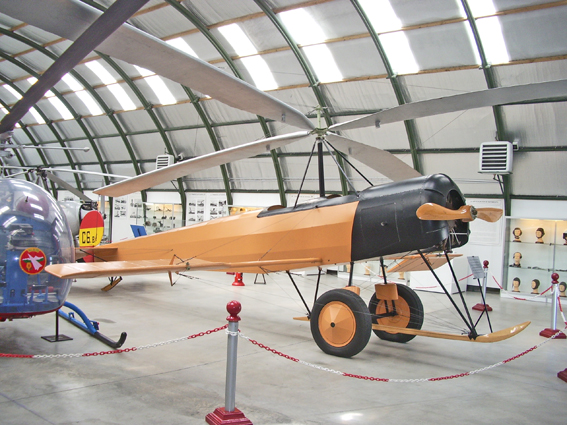An autogyro is a strange flying machine resembling a helicopter but has no engine power to the rotor. Forward thrust is provided by a conventional propellor, usually mounted at the back. There are no wings; lift is provided by the rotor blades. Power for rotation comes from the wind moving through the rotor, like a child’s windmill. I set out to fly in one.

To get the autogiro into the air, its propellor pushes the machine forward, and the slipstream flows through the backwards tilted rotor. When the rotor is up to speed, it is tilted slightly forward to provide upward lift. Because the rotor blades are long and heavy, it takes a while to get them going. Modern machines have a flexidrive from the engine to start them off. The drive is disconnected when the rotor is up to speed, about 200 rpm.
Flight
It works.
I sat in the open cockpit of a Mafni M16 behind my pilot, Andy, and with the rotor twirling, we lifted over Popham Airfield. It was a cold and grey day, and the cloud base had fallen to 600 feet. Flying low gives a greater sense of speed, heightened by the whip of the wind in the face and the open cockpit from which one can lean out and look directly below.
While flying West, parallel to the A303, we searched for Andover. We spotted the industrial estate in the murky air, then turned North and East over Whitchurch and to Overton. North of Overton is a radio mast we must avoid as its top will be in the cloud. I am familiar with the A34 from the air from my glider flights, but then we are at 2000 feet rather than 600. A pig farm at Whitchurch usually provides us with a thermal.
We flew at 70 knots (80 mph), and I was surprised how stable we were. The rotor acts like a gyro and resists any turbulence. Increasing engine power gives greater airflow through the rotor and height increases. To go faster, the rotor is tilted forward. Tilt it left or right to turn. If the engine fails, the rotor continues to turn, and you float gently to the ground like a sycamore seed. I cut the engine, and we descended gently to land.
We sped up to 100 knots (115 mph) during the flight and slowed to zero. I looked over the side at the trees 500 feet below. I tried a few turns, which were easy. A gyrocopter will turn in tight circles.
With the light fading, we flew back to Popham, glad of the lamp shining to guide us to the runway, where we touched down. It was over too soon. I will try it again in the summer.

Invention
Gyrocopters or autogyros became known when James Bond flew one in the film You Only Live Twice. His craft was called Little Nellie, a tiny machine built by Wing Commander Ken Wallis. Little Nellie is now in the Shuttleworth Collect at Old Warden.
Autogyros were invented in Spain by Juan de la Cierva in 1923. He founded the Cierva Autogyro Company in Farnborough in 1925. Initially, there was a problem because the autogiro tended to roll over on take-off. This was because the rotor blade going forward produced more lift than the one going backwards on the other side. They solved the problem by changing the pitch of the blades as they rotate, cyclic pitch control. This is applied to helicopters as well. Autogyros had a reputation for instability in the early days. Once we learned to design them so that the lines of force of lift and thrust passed through or close to the centre of gravity, they became stable.

Autogyros have had limited use so far. The military has used them as observation posts for artillery, and because they fly slowly, they are used in surveillance roles. Helicopters are preferred because of their vertical take-off and ability to lift heavy loads. But, as an aeronautical engineer told me, helicopters are the most efficient means man has discovered of converting money into noise.
The Magni M16 may look small and frail, but it holds the world autogyro record for height – 27,556 feet – over Italy, flown by Donatella Ricci in 2015. James Ketchell flew around the world in one, landing finally in Basingstoke after 122 separate flights, taking 175 days, and completing in 2019.

Technical
For the Teccies
Aircraft Magni M16C by Magni Gyro C0, Tandem trainer
Max takeoff weight 500Kg, Range 700 miles
Rotax 914 UL 4 cylinder turbocharged engine, Max revs 5800 rpm, 115 hp
If you would like to try a flight contact:-
The Gyrocopter Experience Basingstoke
Popham Airfield, Winchester SO21 3BD.
07905 059 789





Marvellous!
An Interesting article. Live in Chandlers Ford but currently reading this article in Ethiopia where my wife is from. Out here for 6 Months . Back May 2024. Temp 23C with clear blue skies. Rgds.
Malcolm & Rose Pickup.
Malc2901@gmail.com.
Excellent article, I am doing an autogyro flight on Saturday and it’s put me at ease. Thank you for posting this!
I hope you enjoyed the flight. I’m a glider pilot, but if I weren’t, I’d learn to fly an autogyro.